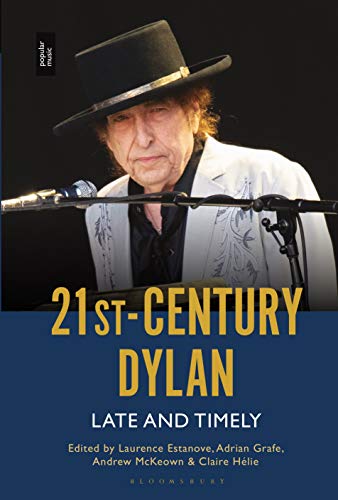 This is a timely release from publishers Bloomsbury, reflecting the book’s full title, ‘21st Century Dylan: Late and Timely’. As many will know, Bob Dylan will celebrate his 80th birthday on the 24th May this year, 2021, yet his work is as relevant now as it has ever been. Unlike many artists whose creativity diminishes with age, Dylan seems to have still unplumbed depths of creativity and reserves of talent that would be enviable in artists half his age. Since 1997’s ‘Time Out of Mind’, Dylan seems to have hit yet another rich seam of songwriting and recording, producing albums that will rate among his best work when historically evaluated; but it’s not just his music that continues to shine. In this later period of his life, he has mounted major exhibitions of his paintings and sculptures that have drawn critical and public acclaim and he has, of course, been acknowledged for his contributions to the written word with a Nobel Prize for Literature, awarded in 2016.
This is a timely release from publishers Bloomsbury, reflecting the book’s full title, ‘21st Century Dylan: Late and Timely’. As many will know, Bob Dylan will celebrate his 80th birthday on the 24th May this year, 2021, yet his work is as relevant now as it has ever been. Unlike many artists whose creativity diminishes with age, Dylan seems to have still unplumbed depths of creativity and reserves of talent that would be enviable in artists half his age. Since 1997’s ‘Time Out of Mind’, Dylan seems to have hit yet another rich seam of songwriting and recording, producing albums that will rate among his best work when historically evaluated; but it’s not just his music that continues to shine. In this later period of his life, he has mounted major exhibitions of his paintings and sculptures that have drawn critical and public acclaim and he has, of course, been acknowledged for his contributions to the written word with a Nobel Prize for Literature, awarded in 2016.
Dylan is, and always has been, a complex and multi-layered talent and it is this complexity that is really at the heart of this book. ‘21st Century Dylan’ is a collection of essays from a wide range of sources – historians, musicologists, film writers, professors of literature – it is a fascinating collection of writings about a fascinating artist and is a fitting celebration of his talent at this point in his life. These essays have been assembled by an impressive team of editors; Laurence Estanove, from the University of Strathclyde, holder of a PhD in English Literature who has written extensively on popular music and on poetry; Adrian Grafe of the Université d’Artois, a Fellow of the English Association and published author; Andrew McKeown, writer, radio host and lecturer in English at the University of Poitiers and, finally, Claire Hélie, who holds a PhD in North of England Poetry and is a Senior Lecturer at the Arts Department of the Université de Lille. They have pulled together a total of fourteen essays covering a range of subjects that include Dylan’s films, his many awards over the years, his ability to edit and re-interpret his own works, the use of his songs in advertising, his use of different moods and emotions in both his writing and his visual work – this book covers a lot of, very diverse, ground.
As you will probably gather from what’s been said so far, this is not a book for the casual fan. This is a book for completists, for the serious fan who wants to get right inside Dylan’s more recent work and really understand the mind of such an iconic artist in his later years. Not every essay in this collection will appeal to every reader but there is something here for everyone and, for those prepared to delve this deep, the book is richly rewarding.
To highlight just three of the chapters in the book, I particularly enjoyed Charles Bonnot’s ‘No Direction Home: When Dylan Does Look Back’, which compares and contrasts Martin Scorcese’s relatively recent ‘No Direction Home’ (2005) with D.A. Pennebaker’s much earlier ‘Don’t Look Back’ (1967); it’s a fascinating study on two films at either end of Dylan’s career and makes for very interesting reading. Another chapter that really grabbed me was Julie Mansion-Vaquié’s ‘Creation and Re-Creation in Dylan’s Performances of ‘Blowin’ in the Wind (1963 – 2016)’. This is an incredibly in-depth analysis of the ways in which Dylan has performed one of his most iconic songs over the years, even down to the different tempos he has used along with detailed diagrams of some of the stage set-ups employed. Finally I’d draw attention to Anne-Marie Mai’s essay ‘Behind Every Beautiful Thing There’s Been Some Kind of Pain: Melancholia in Dylan’s Songs and Paintings’. ‘Not Dark Yet’, the song from which the front section of the title has been drawn, is one of my personal favourite Dylan songs and one that does go deep into a world of melancholia. Linking this use of a very specific feeling to both his written and visual work makes for a very interesting chapter in the book and will encourage many to look at both aspects of his work in a slightly different light. That’s something that all the essays in this book have in common; that enquiring approach, looking for the deeper meanings and the linking concepts that have made Dylan such a diverse and constantly developing artist in his later years
If you’re a serious Dylan fan this book is a must. It’s not a quick or easy read but you’ll be coming back to it for a long time and will continue to be entranced by its contents.
As Dylan himself said in ‘No Direction Home’, “ An artist has got to be careful never really to arrive at a place where he thinks he’s “at” somewhere”. Above all else, this book shows that Dylan is, very much, an artist who is still travelling; taking us with him on an ever-fascinating journey.




[…] and is a fitting celebration of his talent at this point in his life.” Read our whole review here or you can buy your own copy of it here. You can sign up as one of our supporters for just £2 a […]